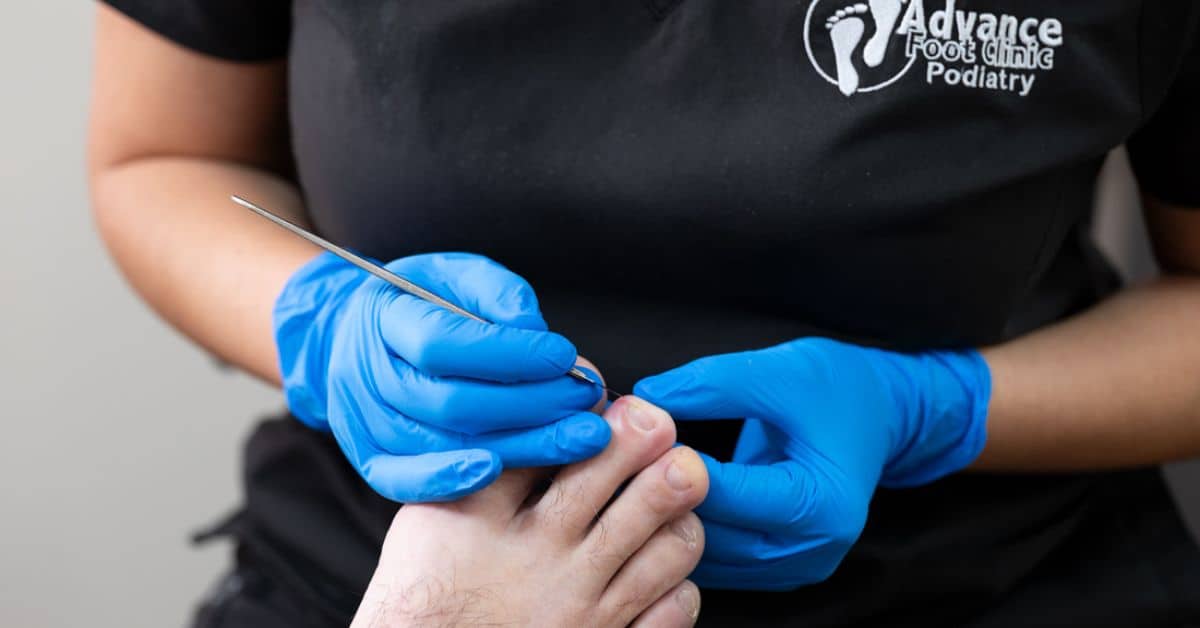TLDR: How to Treat Ingrown Toenails
- An ingrown toenail happens when the nail edge grows into the surrounding skin – causing pain, swelling or infection.
- Soak the toe, lift the nail edge, apply antiseptic like Betadine, and bandage it for mild cases.
- If the nail is deep, infected, or recurring, see a podiatrist for expert treatment.
- In some cases, a minor in-clinic procedure called Partial Nail Avulsion offers lasting relief.
- Prevent future issues with proper trimming and supportive footwear.
When it comes to foot problems, ingrown toenails are among the most painful – and frustrating. They can stop you from working, exercising or even walking without discomfort. Left untreated, they may also lead to infection or ongoing inflammation.
At Advance Foot Clinic, our Brisbane and Mount Isa podiatrists have treated thousands of ingrown toenails. In this guide, we’ll cover what an ingrown toenail looks like, how to prevent and treat it, when to see a podiatrist, and what to expect if you need a minor surgical procedure.
What does an ingrown toenail look like?
When the toenail curves or grows at an angle, it can press into the surrounding skin, leading to inflammation, discomfort and sometimes infection. An ingrown toenail develops when the side of the nail grows into the skin of your toe – most commonly on the big toe. Common symptoms include:
- Redness and swelling around one or both sides of the nail
- Pain when pressure is applied or while wearing shoes
- A visible spike or curve in the nail digging into the skin
- Pus or fluid drainage, which may indicate infection
6 steps to prevent ingrown toenails
The best way to avoid needing ingrown toenail treatment is prevention. Follow these six steps:
- Choose the right tools: Use clean, disinfected clippers designed for toenails.
- Trim straight across: Avoid rounding off the corners – this encourages the nail to grow into the skin.
- Don’t cut too short: Trimming too close to the nail root or trying to round the corners may cause the toenail to curve and grow into the skin. Instead, cut toenails straight across to encourage healthy nail growth.
- Use the correct technique: Cut slowly and carefully. If you have diabetes, reduced sensation, or difficulty reaching your feet, book a clinical podiatry appointment instead.
- Maintain foot hygiene: Keep your feet dry and clean. Change into clean socks daily.
- Wear supportive footwear: Avoid tight fitting shoes or styles that press into the nail fold. Poorly fitted footwear can cause toenail trauma, which often leads to ingrown toenails occurring over time.
How to treat an ingrown toenail at home
If you’ve developed a mild ingrown toenail, you might be able to treat an ingrown toenail at home using these steps:
Warm salt water soaks
Soak the foot in warm water with 2 tablespoons of salt for 15–20 minutes, twice a day. This can reduce inflammation and soften the nail edge.
Lift the nail edge
Using a clean tool (like a file or dental floss pick), gently lift the edge of the nail. This may help it grow above the skin line.
Apply antiseptic
Use Betadine or other antiseptic solutions to help prevent a fungal infection or bacteria from entering the nail bed.
Pack under the nail
Place a small piece of clean cotton under the nail edge to hold it above the skin. You can also use sports tape to gently pull the skin away from the nail.
Cover with a bandage
After treatment, apply a clean bandage to protect the toe.
Use an antibiotic cream
If the area becomes red or warm, this may be an early sign of infection. Ingrown toenail treatment in Australia might include a suitable antibiotic ointment for ingrown toenail, which can be purchased at most pharmacies. For a severely infected or infected ingrown toenail, oral antibiotics may be necessary alongside podiatric care.
What to put on an ingrown toenail
Wondering what to put on an ingrown toenail? After soaking, you can apply an antiseptic like Betadine, followed by an antibiotic cream for ingrown toenail in Australia (available over the counter at most pharmacies). These can help reduce infection risk — but won’t resolve the underlying nail growth issue. If pain, swelling, or pus is present, it’s time to see a podiatrist.
When to see a podiatrist for ingrown toenail management
Home remedies are worth trying. But you may need professional foot specialist help to manage your ingrown toenail pain, especially if it has become an infected ingrown toenail, or if you experience:
- A sharp toenail spike penetrating the nail fold
- Swelling in the surrounding skin of the affected toe
- Recurrence of the problem – also known as recurrent ingrown toenails
- Increased risk of severe complications due to diabetes or immunosuppression
“Every case of an ingrown toenail is different – some need simple trimming, others require a minor procedure. That’s why seeing a podiatrist is the safest way to treat the problem and avoid complications.”
— Cherize Vorster, Podiatrist at Advance Foot Clinic
What to expect at your podiatry appointment
Preparing for your appointment
Avoid self-treating the nail right before your visit – especially cutting it. Gently wash your feet but don’t apply creams or ointments unless advised. Wear sandals or roomy shoes to avoid putting pressure on the toe.
Does ingrown toenail treatment hurt?
Not usually. Conservative trimming is typically painless. For surgical procedures, your podiatrist will numb the toe with local anaesthetic – often needle-free – so you don’t feel a thing during treatment.
In-clinic ingrown toenail treatment
Your podiatrist will assess the nail and recommend the most appropriate treatment:
Conservative nail trimming
For minor cases, the podiatrist may carefully trim and reshape the nail. You’ll also be shown the correct way to cut toenails to avoid repeat problems.
Partial Nail Avulsion (PNA)
In moderate to severe ingrown toenail cases, your podiatrist may perform a Partial Nail Avulsion – also referred to as nail avulsion or phenol nail surgery. This surgical treatment removes part of the nail plate, alleviating pressure on the surrounding skin.
If you’re suffering from ingrowing toenails that don’t resolve with conservative treatment, this is often the most effective long-term solution.
Your podiatrist may also perform a partial matrix excision, where a section of the nail matrix is chemically or surgically destroyed to prevent regrowth of the offending nail edge. This ensures the toenail grows straight rather than curving into the skin.
Aftercare following podiatry treatment
Proper aftercare is key to avoiding complications and speeding up recovery:
- Rest the foot for 24–36 hours
- Keep the dressing dry and clean
- Avoid tight shoes
- Don’t drink alcohol or take aspirin (can increase bleeding)
- Attend your follow-up appointment for wound review
Following ingrown toenail surgery, such as matrix and phenolic ablation, your podiatrist will provide wound care advice. Most patients experience relief from ingrown toenail pain within days – especially when the affected foot is rested and elevated post-treatment.
Can ingrown toenails get infected?
Yes – especially if the nail breaks the skin. Look for:
- Increasing redness
- Swelling or throbbing
- Yellow, green or bloody discharge
- Warmth and pain around the area
If you notice these signs, seek care immediately. In some cases, oral antibiotics may be required alongside podiatry treatment. Keeping the area clean, avoiding pressure, and using topical treatments like Betadine can help prevent infection in early stages.
Does Betadine help ingrown toenails?
Yes – Betadine is an antiseptic that can help reduce the risk of infection in minor ingrown toenail cases. Apply it after soaking and before bandaging the toe. However, Betadine won’t solve the structural cause. If the nail is growing into the skin, you’ll still need podiatric care for long-term relief.
Book ingrown toenail treatment with Advance Foot Clinic
Ingrown toenails can be painful – but they’re also treatable. If you’re searching for ingrown toenail treatment in Australia, Advance Foot Clinic offers expert care across Brisbane and Mount Isa. Whether it’s a once-off flare-up or a recurring issue, our podiatrists can tailor a treatment plan to your needs.
Book your ingrown toenail treatment today or call 1300 76 33 66 to find your closest clinic.


